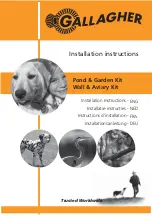
STEP 2: Assemble the Required Tools
Here is the list of tools you will need.
1.
Straight edge spade or power edger
2.
Wire cutter/stripper
STEP 3: Prepare Twisted Wire Lengths First
Prepare the twisted lengths of wire. From your system layout
sketch, determine the length required for each twisted pair.
Cut two equal lengths of wire for each required twisted pair.
With the pair of wires side by side, put one end of each wire
in a power drill and spin the wires until there is approximately
one twist per inch of wire. Do not over-twist because this
could damage the wire. Repeat for each required pair.
STEP 4: Layout the Boundary Wire Above Ground
Before burying your boundary wire, we recommend that you
run the complete loop of wire, make all connections, and use
the receiver collar to fully test the system with the wire
above ground. Referring to the sketch you made of your
system layout, run and connect the wire loop above ground,
connect it to the Transmitter Base Station.
Installation Tip: Leave a little (about 15 inches) slack in the
wire periodically along the perimeter and at the corners of
the layout so you have a little extra wire when needed to
repair a break in the loop. Wind the 15-inch slack into a 5
inch diameter coil and bury it with the wire.
Choose locations for the slack that are easily identified by a terrain
feature and make a map of them.



































